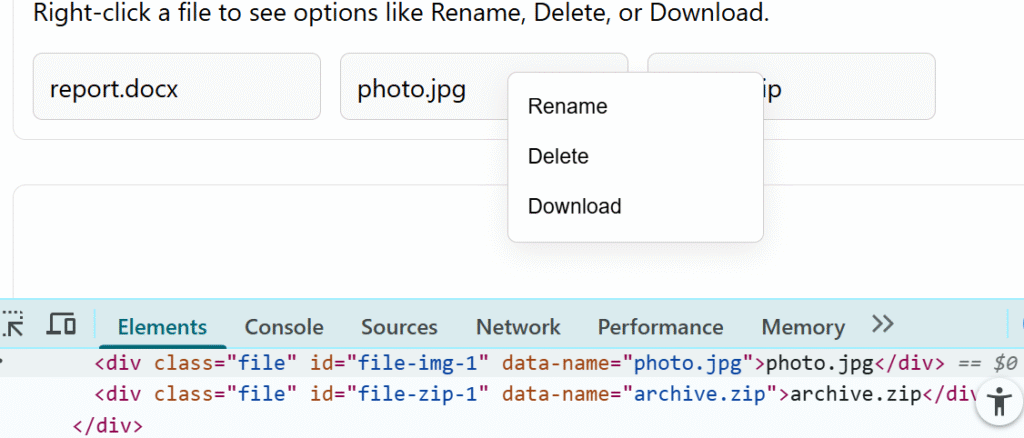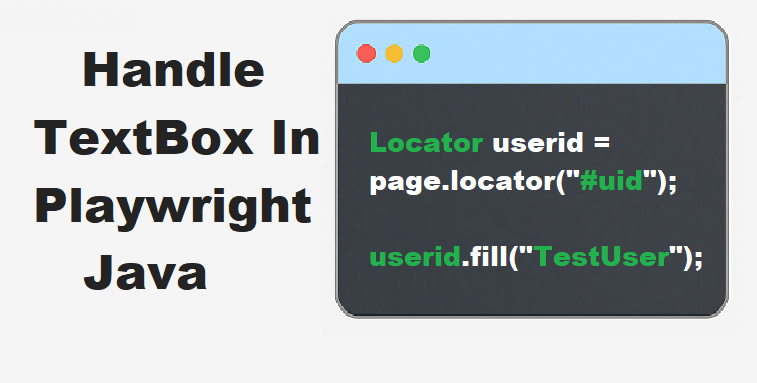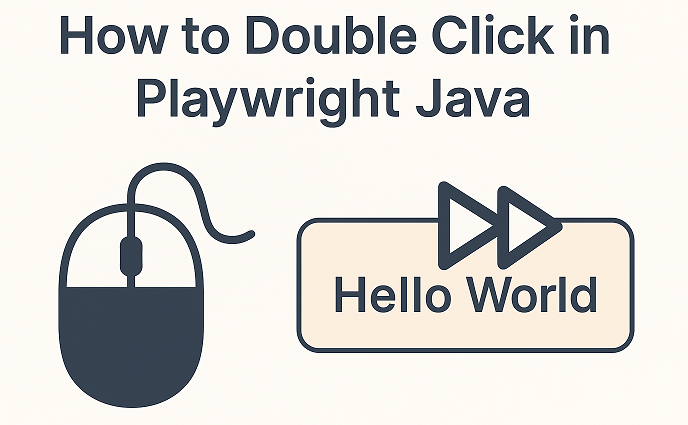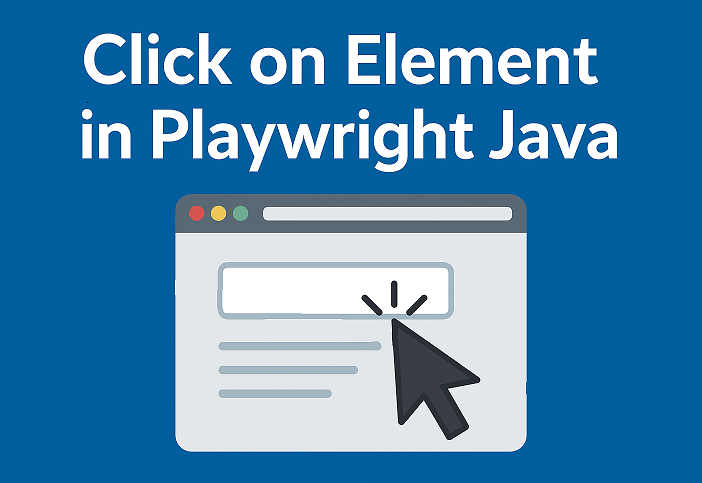Last updated on November 18th, 2025 at 05:06 am
Right-click actions are important in many test scenarios, and this guide will help you understand how to use right-click Playwright Java simply and clearly. Many applications use right-click to open context menus, trigger hidden actions, or load advanced user options. Therefore, testers need to know how to automate this action step by step.
If you are also looking for basic click actions, check out my guides on Mouse Left Click in Playwright Java and Mouse Double Click in Playwright Java.
In this tutorial, you will learn different ways to perform a right click. You will also see how to work with the context menu, how to use Playwright Java mouse actions, and how to validate that the right click worked correctly. Code examples are included so you can follow along easily.
- What Is a Right-Click Action in Playwright Java
- How to Right-Click an Element in Playwright Java
- Perform Right-Click Using Mouse Class in Playwright Java
- How to Open a Context Menu in Playwright Java
- Validate Right-Click Actions in Tests
- Right-Click Not Working? Common Fixes
- Real Use Cases of Right-Click in Automation
- Conclusion
What Is a Right-Click Action in Playwright Java
A right-click action is a mouse interaction that opens a context menu or triggers a specific event on a web element. Many applications rely on a right-click to reveal extra options that are not visible in normal buttons or links. For example, file managers, tables, and admin tools often display hidden features through a right-click event.
In Playwright Java, you can automate this action just like a real user. When you perform a right-click on an element, Playwright sends a mouse button event to the browser. This event makes the browser open a context menu or run the expected script on that element. Understanding this behavior helps you select the right locator and choose the best method for your test scenario.
How to Right-Click an Element in Playwright Java
The most common way to perform a right-click on an element in Playwright Java is by using the click method with the button set to right. This method is simple, reliable, and works well when the element is visible and ready for interaction.

Below is the basic example:
import com.microsoft.playwright.options.MouseButton;
// Right-click using click options
page.click("#file-img-1", new Page.ClickOptions().setButton(MouseButton.RIGHT));In this code, Playwright sends a right-click event directly to the element. It works for most UI components that show a context menu or trigger a custom script. Before using this method, make sure the element is visible and not covered by another element.
You can also combine this method with wait conditions if the element loads after a user action. This helps keep your tests stable and easy to maintain.
Perform Right-Click Using Mouse Class in Playwright Java
You can also perform a right-click using the Mouse class in Playwright Java. This method gives you more control because it uses direct mouse movements. It is helpful when you want to right-click at a specific position or when the element needs precise pointer placement.
Here is a simple example:
// Move the mouse and perform a right-click
Locator box = page.locator("#cms-1");
box.hover();
page.mouse().click(box.boundingBox().x, box.boundingBox().y,
new Mouse.ClickOptions().setButton(MouseButton.RIGHT));In this example, the mouse moves to the element first. After that, Playwright performs a right-click at the element location. This is useful when hover effects or animations affect how the UI behaves.
Use this method when normal click options fail or when you need more control over pointer actions.
How to Open a Context Menu in Playwright Java
A right-click often opens a context menu on web applications. This menu may show options like Edit, Delete, Download, or custom actions created by the developer. With Playwright Java, you can easily trigger this menu and interact with the items inside it.
Here is a simple example of opening the context menu:
// Open context menu with a right-click
page.click("#file-img-1", new Page.ClickOptions().setButton(MouseButton.RIGHT));After the context menu appears, you can select an item using a locator. For example:
// Click an item inside the context menu
page.locator("button:has-text('Delete')").click();Make sure the context menu is visible before clicking its items. You can add a short wait or use an assertion to confirm it is displayed. This helps avoid flaky tests and keeps your automation stable.
Validate Right-Click Actions in Tests
After performing a right-click, your test should confirm that the expected action happened. This could be a visible context menu, a new option on the screen, or a script triggered by the right-click. Validating the result helps you ensure that the UI behaves correctly.

Here is an example of checking if a context menu appears:
import org.testng.Assert;
// Perform right-click
page.click("#cms-2", new Page.ClickOptions().setButton(MouseButton.RIGHT));
// Validate context menu is visible
Locator menu = page.locator("#contextMenu");
Assert.assertTrue(menu.isVisible());You can also check if a menu item becomes enabled or if a specific message appears on the screen. The goal is to confirm that the right-click produced the correct output. This keeps your tests reliable and helps you catch UI issues early.
Right-Click Not Working? Common Fixes
Sometimes a right-click does not work as expected in Playwright Java. This usually happens because the element is not ready or another layer blocks the pointer. Understanding these issues helps you fix the test quickly.
Here are the most common fixes:
1. Make sure the element is visible
If the element is hidden or outside the viewport, Playwright may skip the action. Use locator.scrollIntoViewIfNeeded() if required.
2. Wait for the element to load
Dynamic pages may render the element after a delay. Use a wait to ensure it is attached to the DOM.
page.locator("#menuArea").waitFor();3. Remove or handle overlays
Popups or banners may cover the target element. You can close them or adjust your selector.
4. Use force only when necessary
If the UI is stable but still blocks the action, you can use the force option. Use it carefully.
page.click("#file-img-1", new Page.ClickOptions().setButton(MouseButton.RIGHT).setForce(true));5. Check CSS animations
Animations might delay visibility. Add a short wait or validate the final state before interacting.
By applying these checks, your right-click interactions become smooth and stable.
Real Use Cases of Right-Click in Automation
Right-click actions are commonly used in real web applications, especially when dealing with hidden options, file controls, admin tools, or custom UI elements. Below are some real scenarios where you may need to automate a right-click in Playwright Java. You can also download the ready HTML file to practice these examples locally.
Download practice file: playwright_right_click_practice.html
This file contains four different UI elements: file manager items, CMS content blocks, tables, and interactive widgets. You can load it directly inside Playwright and use the code below to practice right-click interactions.
Full Working Example: Perform a right-click on different elements
The following example demonstrates how to automate right-click actions on a file manager thumbnail, a CMS item, a dashboard widget, and more. Each step includes simple comments so beginners can understand what each line does.
package com.examples.test;
import org.testng.Assert;
import com.microsoft.playwright.Browser;
import com.microsoft.playwright.BrowserType;
import com.microsoft.playwright.Locator;
import com.microsoft.playwright.Page;
import com.microsoft.playwright.Playwright;
import com.microsoft.playwright.options.MouseButton;
public class MouseRightClick {
public static void main(String[] args) {
try (Playwright playwright = Playwright.create()) {
// Launch Chrome browser in headed mode
Browser browser = playwright.chromium().launch(new BrowserType.LaunchOptions().setHeadless(false));
// Create a new page
Page page = browser.newPage();
// Load the local HTML file for right-click practice
page.navigate("file:///D:/playwright_right_click_practice.html");
// -----------------------------------------------------------
// 1. FILE MANAGER SECTION: Right-click a file image
// -----------------------------------------------------------
// Perform right-click on file image using click options
page.click("#file-img-1", new Page.ClickOptions().setButton(MouseButton.RIGHT));
// Capture context menu and assert it is visible
Locator filemenu = page.locator("#contextMenu");
Assert.assertTrue(filemenu.isVisible(), "File context menu not visible");
// Click Delete option from context menu
page.locator("button:has-text('Delete')").click();
// -----------------------------------------------------------
// 2. CMS / ADMIN SECTION: Right-click a CMS content item
// -----------------------------------------------------------
// Perform right-click on CMS item
page.click("#cms-2", new Page.ClickOptions().setButton(MouseButton.RIGHT));
// Validate context menu is visible
Locator cmsmenu = page.locator("#contextMenu");
Assert.assertTrue(cmsmenu.isVisible(), "CMS context menu not visible");
// Click Edit action from the menu
page.locator("button:has-text('Edit')").click();
// -----------------------------------------------------------
// 3. INTERACTIVE UI SECTION: Right-click on dashboard widget
// -----------------------------------------------------------
// Scroll element into view (in case it is lower on the page)
Locator widget = page.locator("#dashboard-widget");
widget.scrollIntoViewIfNeeded();
// Perform right-click on dashboard widget
page.click("#dashboard-widget", new Page.ClickOptions().setButton(MouseButton.RIGHT));
// Validate context menu visibility
Locator uimenu = page.locator("#contextMenu");
Assert.assertTrue(uimenu.isVisible(), "UI widget menu not visible");
// Select Configure action
page.locator("button:has-text('Configure')").click();
// Close the browser
browser.close();
}
}
}Conclusion
Right-click actions are an essential part of many real applications, and Playwright Java makes it easy to automate them with simple mouse controls and click options. In this guide, you learned how to use different methods to perform a right click, trigger context menus, handle file manager items, work with CMS elements, and interact with custom UI widgets. You also saw a full working example along with a practice HTML file so you can try everything on your own system.
By combining locators, click options, and proper assertions, you can build reliable tests that simulate real user behavior with accuracy.




